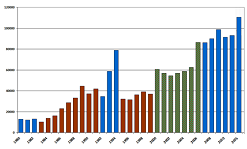(1) Björn Söder i Svd: Sverige bör inte delta militärt i Libyen
(2) Kommentar av Nato-expert i Nettavisen: - De burde ha lært av Bush
(3) Mellanösternforskare i SVT: "Risk för anarki om Kadaffi störtas"
(4) View from the Right om Diana west-artikel: Fighting for our enemies
"In Iraq, in Afghanistan, in Gaza, we helped make the world safe for sharia. But, says Diana West, in Libya we have gone further: we are making the world safe for jihad"
(5) I Brussels Journal skrev i måndags Johnny Fincioen inte så optimistiskt, men uppriktigt.
"I have serious doubts about the power of our European and Arab ‘partners’ to do more than postpone Gadhafi’s victory. Word is, he controls Libya again with the exception of the city of Benghazi. It is very possible that before next week is over, the entire country lives again under his brutal control."Vidare nämnde han två dålig argument resp. två goda argument för att Obama inte skulle involvera sig militärt i Libyen. De två goda skälen:
"1. We don’t know who the rebels are. History teaches us: the most radical wing hijacks all revolutions. In the Muslim countries, the radicals are also the best organized. They are the devout Muslims, organized around radical Mosques, aiming to install Sharia law with the zeal to expel/murder the infidels.
2. What will we do with, for example, Bahrain, Yemen and Saudi Arabia, when the local protests become full-fledged revolts? Will we arm and support the rebels in these countries too? Although we know already they are of the radical Muslim breed."
(6) I artikeln Beyond a No-Fly Zone: How to Protect Civilians in Libya av Michael Knights på Washington Institute, hävdas att flygförbud inte är särskilt effektivt:
"So far, the nations involved in the operation have embraced the tactical mechanisms without clearly articulating how they will protect civilians in western Libya. The United States has prepared the way for a no-fly zone (though it appears eager to hand off most of the actual enforcement to its coalition allies), while NATO has expressed willingness to lead the enforcement of an arms embargo at sea and in the air. Yet even if both mechanisms function perfectly, the Qadhafi regime would still be able to use artillery, tanks, and other ground forces to liquidate pockets of resistance in the west. In fact, this exact outcome occurred in southern Iraq in the early 1990s, when Saddam Hussein's regime was embargoed and subject to a no-fly zone yet still managed to pummel southern Iraqi resistance, drain the marshes, and drive tens of thousands into exile in Iran."Michael Knights påpekar att flygvapnet svårligen försvarar sig mot detta och tror att en period utan förbättring kan tära på alliansens sammanhållning.
(7) Flygförbudets ineffektivitet behandlar även Big Peace-artikeln In Libya A ‘No Drive Zone’ Would Be Better.
"The doctor told the Washington Post he had stopped counting the injured and that the hospital is running out of virtually all supplies and medicines.”This no-fly zone doesn’t mean anything to us because Gaddafi only had a few planes and they were doing nothing,” said the doctor, who fears Libyan regime forces will retake the city. “We need a no-drive zone because it is tanks and snipers that are killing us.”"
Relaterat i media: BLT 1 2 SvD 1 2 3 SVT 1 2 3 HD 1 2 3 DN 1 2 GP 1 2 3 4 Dagen 1 2 ST EK VL VG
Andra bloggar om: samhälle, utrikes, krig, war, NATO, Afrika, USA, Europa, Libyen, Libya


Comments
No responses to “Artiklar om Libyen-insatsen”
Skicka en kommentar
Kommentera relevant och undvik invektiv.
Obs! Endast bloggmedlemmar kan kommentera.